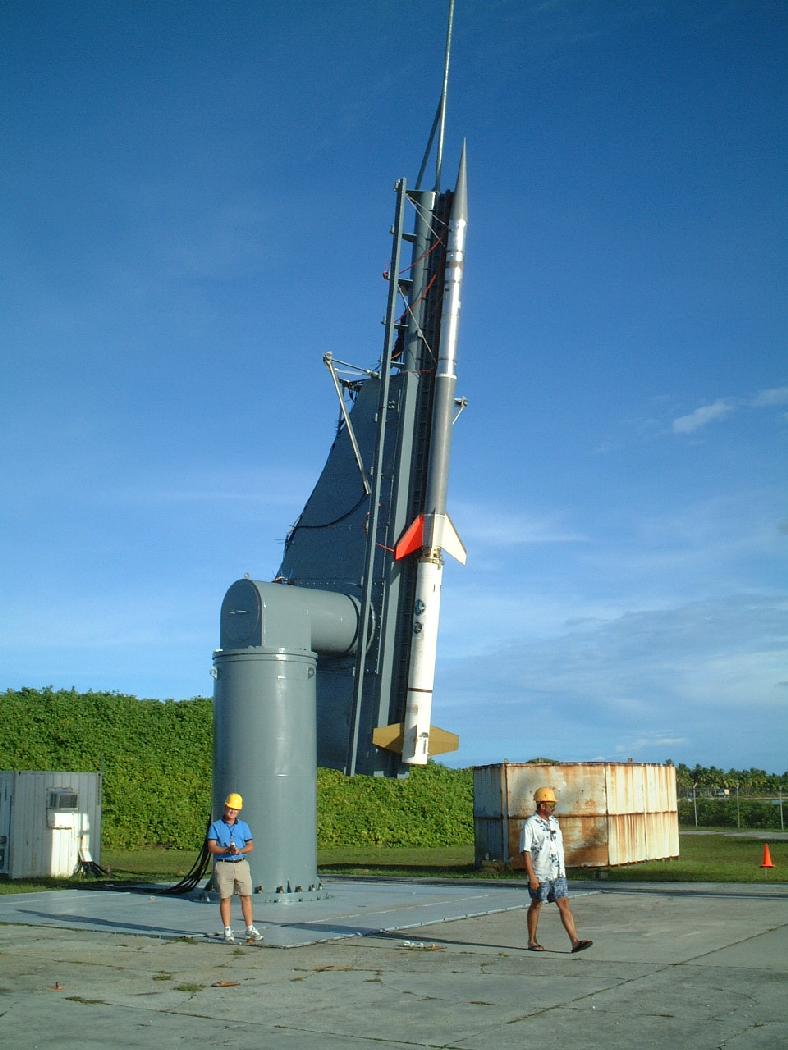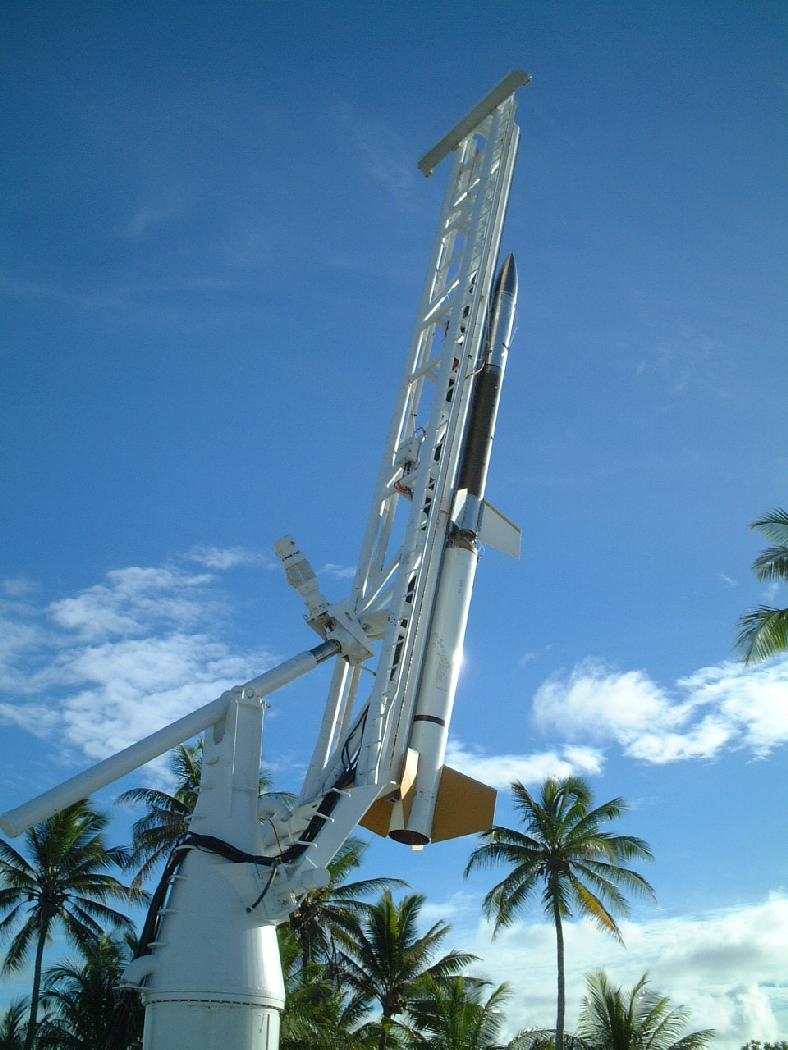 EQUIS II Spread F
investigation
EQUIS II Spread F
investigation  EQUIS II Spread F
investigation
EQUIS II Spread F
investigation A Washington Post story about these experiments is here.
A NASA press release with more details is here.
This page describes a NASA investigation into the electrodynamics of the postsunset equatorial F region ionosphere and the bearing this has on thin scattering layers that form there. Coherent scatter from such layers has been observed at the Jicamarca Radio Observatory in Peru for many years and generally occurs as a precursor to more fully developed equatorial spread F (ESF). The thin bottom-type scattering layers have not been investigated with sounding rockets before and are difficult to study with satellites, being thin and often residing at low altitudes. We study them and the environment in which they reside because both seem to have a bearing on the ultimate emergence of spread F and on the communications and navigation systems interruptions that result.
The investigation was carried out from Kwajalein Atoll in the Marshall Islands using a combination of sounding rockets and radar support. David Hysell was the principle investigator for the experiment. Co-investigators Miguel Larsen (Clemson), Charles Swenson (Utah State University), Timothy Wheeler (Penn State), and Martin Sarango (Geophysical Institute of Peru) supplied payloads for the sounding rockets and will collaborate on data analysis.
Two sets of launches took place on separate nights from the Roi Namur range at the north of Kwajalein Atoll. Each set consisted of an instrumented payload launched north- westward, and two chemical release (TMA) payloads, one containing two canisters launched north westward, and one containing a single canister launched to the northeast. The instrumented payloads measure upleg and downleg plasma density, temperature, collision frequency, and electric field profiles while the chemical release payloads permit the measurement of neutral wind profiles at three distinct locations.

|
On the evening of August 7, 2004, we successfully launched the first group of sounding rockets in our equatorial spread F investigation from Roi Namur. The launches occurred during a spread F event which began with the appearance of a bottomside scattering layer in the Altair radar scans at about 2030 LT. The layer extended over a broad spatial extent several hundred kilometers wide that included the flight path of the instrumented rocket. The bottomside layers were accompanied by an exceptionally dense and structured sporadic E layer along with some unusual structuring in the valley region which we have not seen with Altair before. The bottomside layers persisted throughout the rocket launches. |
By the time the instrumented rocket was launched into the bottomside layer at 2053 LT, spread F plumes began to appear to the west of the range that continued to form and drift eastward for the remainder of the night. Chemical release rocket launches followed at 2107 LT and 2111 LT. Radar data were collected until about 2200 LT which showed both field aligned irregularities and deep density depletions associated with a fully-developed ESF event. Ionograms were completely blanketed by the sporadic E layer until the end of the experiment, when severely spread F-region traces were finally visible.
| The rocket trajectories were nominal, and all of the payload events occurred as planned, including the boom releases and the successful deployment of three TMA trails. The observing conditions from the ground were good at the remote optical ground stations, and the TMA trails were clearly visible from Roi. A cursory examination of the telemetry suggests that the rocket instrumentation performed satisfactorily, producing the in situ data needed to carry out our investigation. The magnetic ACS seems to have performed very well; only a very minor attitude adjustment was made during the programmed realignment at apogee. Preliminary analysis also suggests that the beacon experiments carried by the chemical release payloads functioned normally throughout the flights. |

|
On August 15, we launched the second group of sounding rockets in our equatorial spread F investigation. The launches occurred during a spread F event which again began with the appearance of a bottomside scattering layer in the Altair radar scans, this time at about 2000 LT. The layer in question persisted throughout the entire launch sequence and was followed by a long train of eastward-drifting spread F plumes. The layer was higher and stronger than the one investigated on August 7. The plumes, meanwhile, moved in after the launch sequence and were still visible at 2230 LT when Altair radar data acquisition ceased.

|

|

|
The instrumented rocket was launched at approximately 2022 LT and experienced a nominal flight. The ACS appears to have functioned normally, making only a small attitude adjustment at apogee as programmed. The USU and PSU instruments also appear to have functioned properly, measuring electric fields, electron number densities, and other parameters throughout the flight. All flight events appear to have occurred normally at this time, and we are looking forward to carrying out the analysis of the time series data we acquired.
The first chemical release rocket was launched at approximately 2047 LT along a westward flight path that followed the instrumented rocket. Upleg and downleg TMA releases were observed from two remote optical sights, and we believe that the quality of the resulting images will permit the calculation of neutral wind profiles from each trail. Roi was clouded over during the launch sequence, and eye-witness reports of the characteristics of the trails are not yet available.
The second chemical release rocket was launched to the north at approximately 2051 LT. However, a flight anomaly seems to have occurred that prevented the planned deployment of the third TMA trail.

|
Data from the Altair radar (left) were used to identify the conditions for
launch and will be useful for placing the rocket measurements in context.
Altair functions as both a coherent and an incoherent scatter radar and
operates at VHF and UHF frequencies simultaneously. By scanning perpendicular
and off perpendicular to the Earth's magnetic field, the radar can
identify both the deep plasma depletions associated with spread F and the
field aligned plasma irregularities produced by the instabilities responsible
for the depletions. Codes useful for processing the raw Altair data are available here. |
 Return to the
Space Science group homepage.
Return to the
Space Science group homepage.